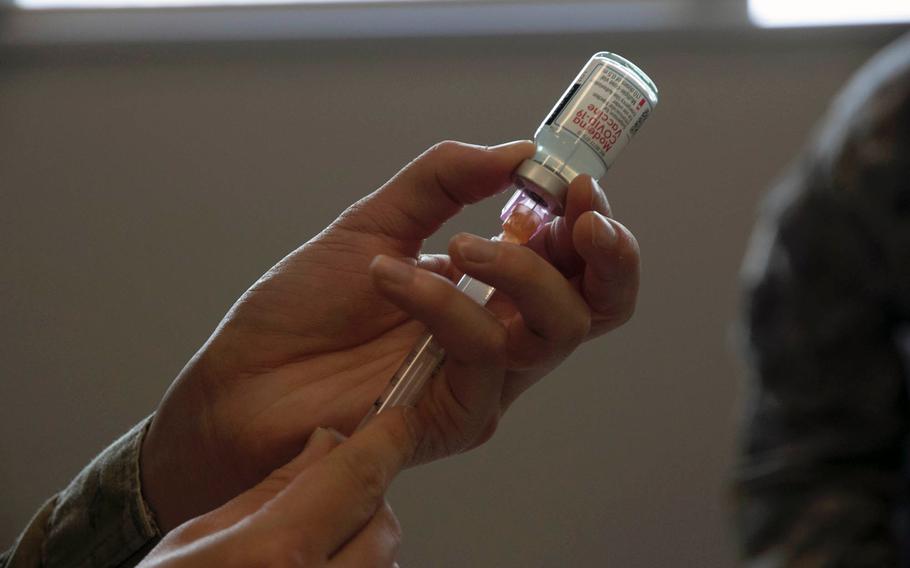
An Air Force health-care professional loads a syringe with Moderna's COVID-19 vaccine at Kadena Air Base on Okinawa, Japan, on Monday, Dec. 28, 2020. (Matthew M. Burke/Stars and Stripes)
Stars and Stripes is making stories on the coronavirus pandemic available free of charge. See other free reports here. Sign up for our daily coronavirus newsletter here. Please support our journalism with a subscription.
The Navy in Guam planned to start inoculating its frontline personnel against the coronavirus Monday, two days after the Moderna vaccine arrived on the island.
A “limited quantity” of the vaccine arrived Saturday at Naval Hospital Guam; first priority are health-care providers and emergency services and public safety personnel, Joint Region Marianas spokesman Navy Lt. Cmdr. Rick Moore wrote in an email Monday to Stars and Stripes.
“The arrival of the COVID-19 vaccine to our region after a challenging year is good news and cause for measured optimism,” Moore wrote, referring to the respiratory disease caused by the coronavirus.
Guam, a U.S. territory of 160,000, was hit hard by the pandemic. As of mid-November, it had recorded 6,346 coronavirus infections, including 315 U.S. service members, and 100 deaths, the island’s Joint Information Center said at the time. More than 1,900 of those cases were active.
As of Monday, confirmed cases had risen to 7,163, including 330 U.S. service members, and 122 deaths, according to Guam’s Department of Public Health and Social Services.
However, only 133 are under observation, including three on U.S. military facilities. The island recorded 63 positive cases between Dec. 28 and Monday, the department reported.
Vaccines will be administered to U.S. military personnel in three phases, according to the Defense Department.
The next phase involves personnel deploying outside the United States and “critical and essential support personnel,” followed by high-risk individuals and the general population.
The Moderna vaccine is one of two approved by the U.S. Food and Drug Administration for emergency use to combat the virus, which was first reported a year ago in China and reached pandemic proportions within four months. Both vaccines require two shots separated by about a month.
Subjects must volunteer for the vaccine because it’s an emergency measure.
Virus prevention protocols such as social distancing, wearing masks and washing hands to stem further spread are still mandatory even for those who are vaccinated, according to Moore’s statement.
The Moderna vaccine in trials was 94% effective in preventing COVID-19, according to the FDA.
The most common side effects are pain at the injection site, tiredness, headache, muscle pain, chills, joint pain, swollen lymph nodes, nausea and vomiting and fever, according to the FDA. More people experienced them after the second dose than after the first.
“Joint Region Marianas installations expect to receive additional shipments in the coming weeks to administer to eligible [Defense Department]-affiliated individuals as production and distribution increases,” Joint Region Marianas said in a statement prior to Moore’s email. “All beneficiaries are kindly asked to remain patient as shipments continue to arrive and more vaccines can be administered.”burke.matt@stripes.com Twitter: @MatthewMBurke1